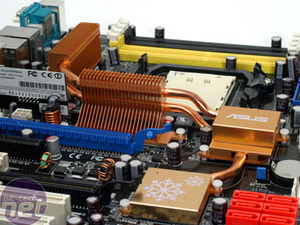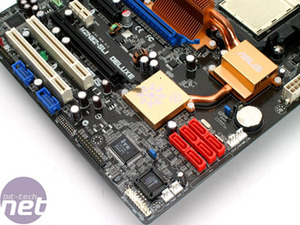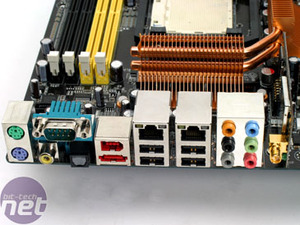Along the left hand edge is the front panel pin out for use with the Q-connector, the parallel port pins (cable not provided), and a pair of USB 2.0 headers in blue. Finally the extra Firewire pins are in burgundy near to the top left corner. Broadly speaking, all of the connectors are well placed around the edge of the board. The PCI slot that you’re most likely to use is the bottom one, as it isn’t adjacent to a PCI-Express x16 slot. This means that plugging in extra USB/Firewire ports will be a case of musical sockets unless you have hands the width of a credit card.

 The top edge of the board is the third party chipset domain; containing the Texas Instruments Firewire controller (TSB43AB22A), the two Marvell Gigabit Ethernet controllers (88E116) and finally the ADI SoundMax eight channel audio codec (ADI1988B). It seems strange that ASUS used an ADI codec considering the popularity of Realtek’s high-definition audio codecs. It is hard to suggest whether this is a quality issue for a top-of-the-range board, or a cheaper alternative than the competitors’ offerings.
The top edge of the board is the third party chipset domain; containing the Texas Instruments Firewire controller (TSB43AB22A), the two Marvell Gigabit Ethernet controllers (88E116) and finally the ADI SoundMax eight channel audio codec (ADI1988B). It seems strange that ASUS used an ADI codec considering the popularity of Realtek’s high-definition audio codecs. It is hard to suggest whether this is a quality issue for a top-of-the-range board, or a cheaper alternative than the competitors’ offerings.
The board has two PCI-Express x16 slots with the primary (closest to the CPU socket) coloured blue. Next to this is a PCI-Express x4 slot, which is backward compatible with PCI-Express x1 and x2 add-in cards. Unfortunately, due to its placement next the primary PCI-Express x16 slot, it is rendered unusable if a video card with a dual-slot cooling solution is installed. While on the topic of dual slot coolers, one of the two PCI slots is usable if a pair of video cards are installed.



 Next to the primary PCI-Express x16 slot, there is the four-pin 12V power socket and the final USB 2.0 header. The WiFi Edition M2N32-SLI Deluxe board includes an onboard WiFi card that is connected to the final USB 2.0 pin header next to the audio ports on the back panel. The bonus of the WiFi Edition board is that the one usable PCI slot can be used for a Creative X-Fi card, rather than a PCI-based WiFi card. The board has more than enough fan connectors with a total of six 3-pin headers and one 4-pin CPU fan with a PWM.
Next to the primary PCI-Express x16 slot, there is the four-pin 12V power socket and the final USB 2.0 header. The WiFi Edition M2N32-SLI Deluxe board includes an onboard WiFi card that is connected to the final USB 2.0 pin header next to the audio ports on the back panel. The bonus of the WiFi Edition board is that the one usable PCI slot can be used for a Creative X-Fi card, rather than a PCI-based WiFi card. The board has more than enough fan connectors with a total of six 3-pin headers and one 4-pin CPU fan with a PWM.
The rear I/O panel is a complete array of everything necessary including: two PS2 ports, a single serial connector, optical and digital RCA S/PDIF out (for input you need to purchase the optional card that plugs into the onboard header), 6 pin Firewire, ESATA, then 4 USB2 in a 2x2 arrangement topped off with both Ethernet ports. Finally the six, 3.5mm jacks offer the 8 channel surround sound.


The board has two PCI-Express x16 slots with the primary (closest to the CPU socket) coloured blue. Next to this is a PCI-Express x4 slot, which is backward compatible with PCI-Express x1 and x2 add-in cards. Unfortunately, due to its placement next the primary PCI-Express x16 slot, it is rendered unusable if a video card with a dual-slot cooling solution is installed. While on the topic of dual slot coolers, one of the two PCI slots is usable if a pair of video cards are installed.




The rear I/O panel is a complete array of everything necessary including: two PS2 ports, a single serial connector, optical and digital RCA S/PDIF out (for input you need to purchase the optional card that plugs into the onboard header), 6 pin Firewire, ESATA, then 4 USB2 in a 2x2 arrangement topped off with both Ethernet ports. Finally the six, 3.5mm jacks offer the 8 channel surround sound.

MSI MPG Velox 100R Chassis Review
October 14 2021 | 15:04







Want to comment? Please log in.